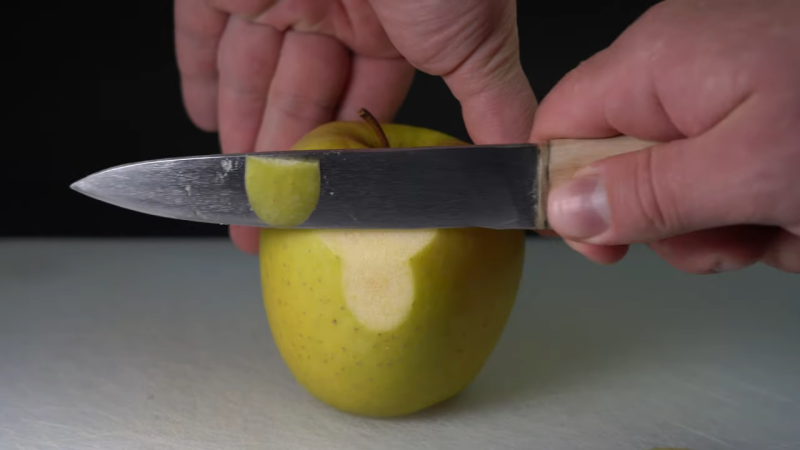Making knives at home has become a popular hobby, thanks partly to reality TV and the free time and idle hands afforded by lockdowns. Depending on how far you get into the hobby, builds can range from assembling and finishing a kit with pre-forged parts, to actual blacksmithing with a hammer and anvil. But pretty much every build includes steel from a commercial supplier.
Not this one. Rather than buy his metal from the usual sources, [Thoisoi]’s first stop was an iron mine in the Italian Alps, where he picked up a chunk of iron ore — magnetite, to be precise. Smelting one’s own iron from raw ore and alloying it into steel is generally not a backyard project thanks to the high temperatures needed, a problem [Thoisoi] solved with the magic of thermite. The iron oxide and aluminum in the thermite mix react in an exceptionally exothermic manner to generate elemental iron, which under controlled conditions can be captured as a more or less pure ingot, ready for forging.
After a test with commercially obtained iron oxide, [Thoisoi] tried his pulverized magnetite. And thanks to the addition of goodies like graphite, manganese, nickel, silicon, and chromium, he was eventually able to create a sizable lump of 402 stainless steel. He turned the metal over to an actual blacksmith for rough forging; it sure seemed to act like steel on the anvil. The finished knife looks good and performs well, and the blade has the characteristic look of stainless. Not a bad result, and all at the cost of a couple of clay flowerpots.
Thanks to [Keith Olson] for this tip.
















This is very interesting. I’ve made my own copper thermite to use in exothermic welds to ground my ham radio tower, but never tried the iron version. It turns out that where I live I can drag a strong magnet along the ground and pick up a lot of very fine particles of magnetite. I still have some aluminum powder, so I think I’ll give that a try.
By the way, the thermite reaction is reduction, so it doesn’t work very well to try to ignite it with things like a torch. A spark starter for a propane torch will work, but much better is to use an inexpensive sparkler like are used here in the U.S. during celebrations like the 4th of July. They are easy to start with a match, and the sparks will set off the thermite.
I have seen guys doing work on railways use some gas burner thing to start their thermite stuff. A torch might be too small / convey not enough energy. A sparkler should do too or some magnesium tape (beware it’s bright). Anyway, please be careful when messing with thermite and molten iron… (Not even sure thermite is legal do use for everybody in my country)
>Are you a cop?
No and i don’t want any problems with them.
I’ve seen a few thermite demonstrations in chemistry class and in rail workshops, everytime they inserted a short length of magnesium tape into the pile, ignited that with a propane torch which in turn ignited the thermite.
You can use a chemical igniter like a potassium permanganate and glycerin starter. They react so violent with each other, it straight up oxidizes the glycerol in a pretty flame.
I once made elemental silicon in a thermite reaction. Excess magnesium and the resulting oxide were removed with HCl. Some magnesium silicide is formed too, burning off as monosilane gas, SiH4. Shame the silicon powder is useless with this low grade purity. Otherwise silicon powder is a standard in x-ray powder diffraction.
/ramble=off
Next try a DIY Bessemer process.
Beating the iron removes some of the excess carbon remaining in the mixture, but proper steel is produced by bubbling air through molten iron to burn away the carbon that was present in the ore and remaining in the metal. Then you add a known quantity back. To qualify as steel, it needs to have less than 1.5% carbon.
The first such mass production method was called the Bessemer process, but since it uses air it also introduces nitrogen which also makes the resulting steel more brittle. The same limitation applies to the wrought iron made in a forge by beating. Modern steels are made with pure oxygen.
Very cool 2 make a knife from foraged iron ore !! Not wanting to be over critical, I would not have opted to produce stainless steel myself as the best knives are normally SHARP knives, which are made from carbon steel and actually go rusty. A good test for a sharp knife is to balance the blade on your finger nail at 45 degrees and see if it slips off or not. If it slips off and lands tip first in your foot, then it’s not sharp !!
Oh man, someone already dug the mine for him! This isn’t from scratch!
No to mention finding the ore deposit!
I thought it was ironic (!) that the mine truck was using steel rails… why not just cut a bit off…
Kiwami has a rival! https://www.youtube.com/channel/UCg3qsVzHeUt5_cPpcRtoaJQ/videos